Invasive species
Invasive species are plants, animals and insects that were brought to a territory where they don’t usually live and have damaging effects on the local ecosystem. With the Water Rangers data platform, you can track many invasive species found in Canada and the United States. Find out more about them below. If you learn to recognize them, make sure to track them and help stop their spread by following best practices!
Track invasive species with our app!
Did you know you can track the following invasive species with our data platform and app? It’s true! Just make sure this feature is enabled in your custom forms.
What these species have in common
You’ll probably notice a ton of similarities between the invasive species listed below. Generally speaking, invasive species have a few major things in common:
1. They threaten native species. Invasive species often make it harder for native species to survive and thrive, reducing biodiversity as a result.
2. Once they’ve established themselves, they’re hard to get rid of. Many invasive species are resilient and can reproduce quickly. As a result, it’s often much easier (not to mention more cost-effective) to prevent the problem as much as possible rather than address it later.
3. There are things you can do to help! The spread of invasive species can be curbed or even prevented by following a few best practices. For more information on these best practices, visit the Government of Ontario’s website.
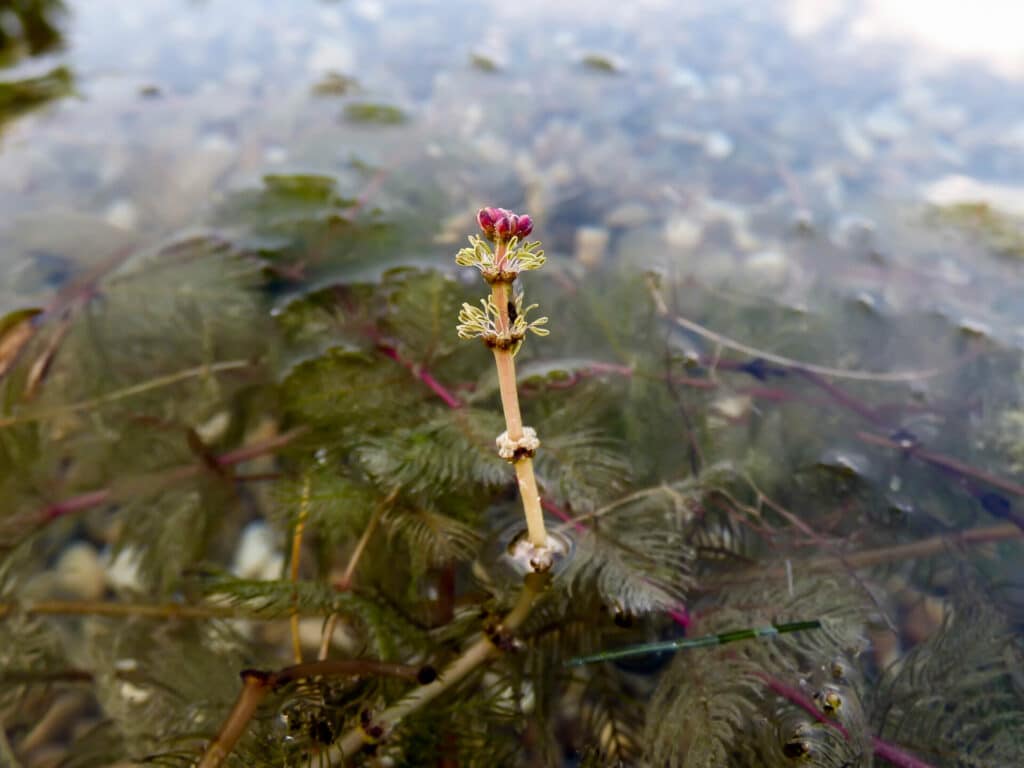
Eurasian Milfoil
Why it’s bad
Eurasian milfoil negatively impacts other plants since it grows and spreads so rapidly, leaving little room for native species to grow. It also negatively affects fish and wildlife since it depletes the water’s oxygen levels when it dies. On top of that, it causes problems for fishing, swimming, boating, and more, since it’s so thick and hard to get rid of.
Where you might find it
Eurasian milfoil is present in numerous places across Canada, including all of the Great Lakes.
It loves to grow in shallow water, but can also be found in water up to 10 metres deep. It typically blooms in late July to early August, and then starts to die off in the fall.
How to identify it
Each strand of Eurasian milfoil will have feather-like green leaves that circle the stem. Each leaf will have 12 or more segments- look closely and count how many you can find!
How to help
Eurasian water-milfoil spreads very easily- new plants can grow from small pieces that break up from bigger, more mature plants. To reduce the chances of this, avoid infested areas and reduce your boat speed when travelling in or near Eurasian water-milfoil infestations. Your boat’s propeller can break off fragments and spread the pieces to new areas.Cleaning off your boat before transporting it to a new body of water is always a good idea, too!
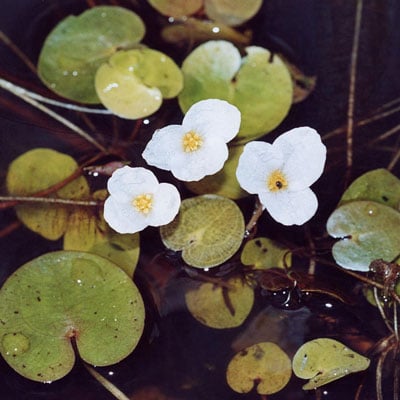
European Frog-bit
Why it’s bad
European frog-bit can be free floating or rooted and can form dense mats of leaves. By covering the water’s surface, it makes it harder for native aquatic plants to get the sun and nutrients they need to survive. When these dense mats die at the end of the fall, the decomposition process reduces dissolved oxygen levels in the water which can be dangerous for plants and animals living underwater.
Where you might find it
European frog-bit has made its way to many lakes in Ontario and Quebec. It can also be found in the United States in New York, Michigan, Vermont and Washington.
How to identify it
This plant looks like native water lilies, but its leaves are smaller (5cm in diameter) and are heart shaped. Its flowers are white with a yellow center.
How to help
European frog-bit is hard to remove once it’s been established. If you notice a small amount of it, you can try to remove it by hand if it’s safe to do so. Once it’s widely dispersed, the best thing to do is try to prevent it from spreading further. Always inspect, rinse, clean, and dry your boat before transporting it from one waterbody to another.
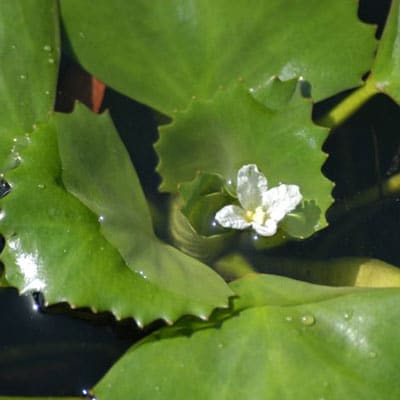
European Water Chestnut
Why it’s bad
Like other invasive species, European water chestnut is an aggressive, fast-growing plant that can crowd out native species and reduce dissolved oxygen levels. This can lead to a reduction in biodiversity, fish kills, and deteriorated water quality.
Where you might find it
European water chestnut can be found in the Ottawa River, in tributaries of the Niagara River and of Lake Ontario, in parts of Southeastern Quebec, and in the northeastern United States.
How to identify it
European water chestnut leaves are green with sharp edges and float on the surface of the water. Its flowers are white, have four petals, and are about 8 mm wide. European water chestnuts produce hard nut-like seeds, 3-4 cm wide. Unlike edible varieties of water chestnuts, these seeds should not be eaten! Once seeds sink to the bottom of the lake, they can produce whole new plants. Older seeds that float cannot reproduce.
How to help
Since European water chestnut grows so quickly, efforts are usually focused on mitigating the problem, rather than eradicating it. This means reducing the spread of the plant if possible, and manually removing it when you can. As always, make sure to wash and dry your boat and fishing gear before transporting them elsewhere.
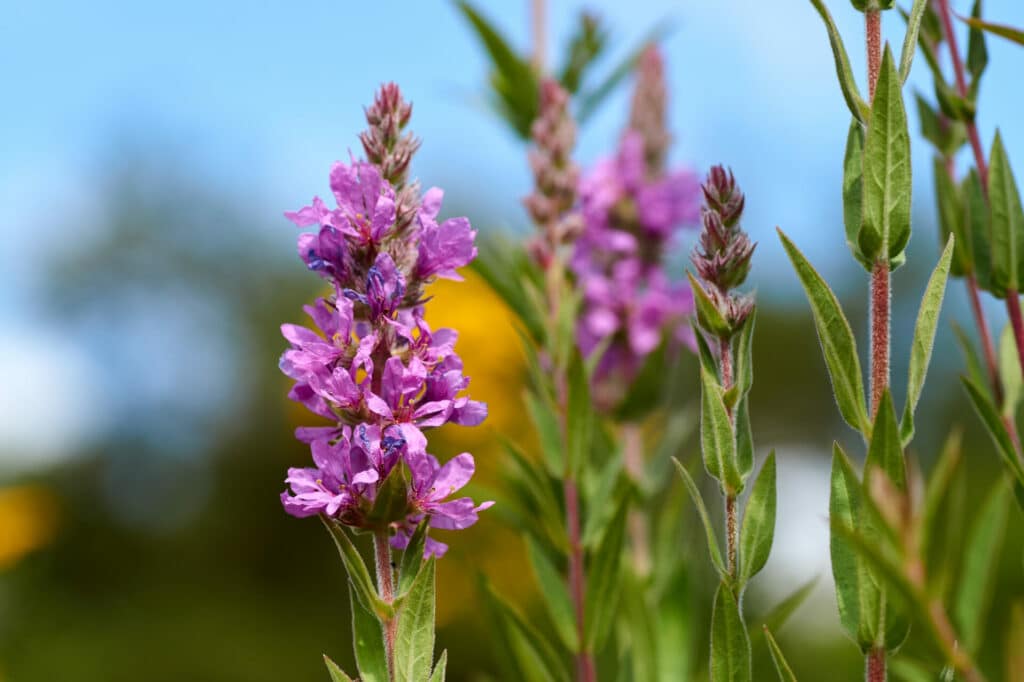
Purple Loosestrife
Why it’s bad
Like other invasive species, Purple Loosestrife is fast growing and easily spread. It reduces habitat for native plants and wildlife, thus preventing them from getting the nutrients they need. Birds, bugs, fish, and more are all affected by this! Not only that, but the presence of Purple Loosestrife can be seriously frustrating for farmers and other landowners.
Where you might find it
Purple loosestrife can be found in almost every Canadian province and in many US states. It loves wetlands, roadsides, and fields.
How to identify it
The stems of this plant are thick and square shaped, and can grow until they’re over 2 metres tall! Most noticeably, the plants have pinkish-purple coloured flowers, and each flower has five to seven petals.
How to help
In recent decades, Purple Loosestrife has become a less severe threat thanks to the introduction of insects that feed exclusively on them. The European leaf-eating beetle is one such insect!
Be careful if trying to remove Purple Loosestrife by hand. The seeds spread very easily, and trying to remove the plant could actually end up spreading it further.
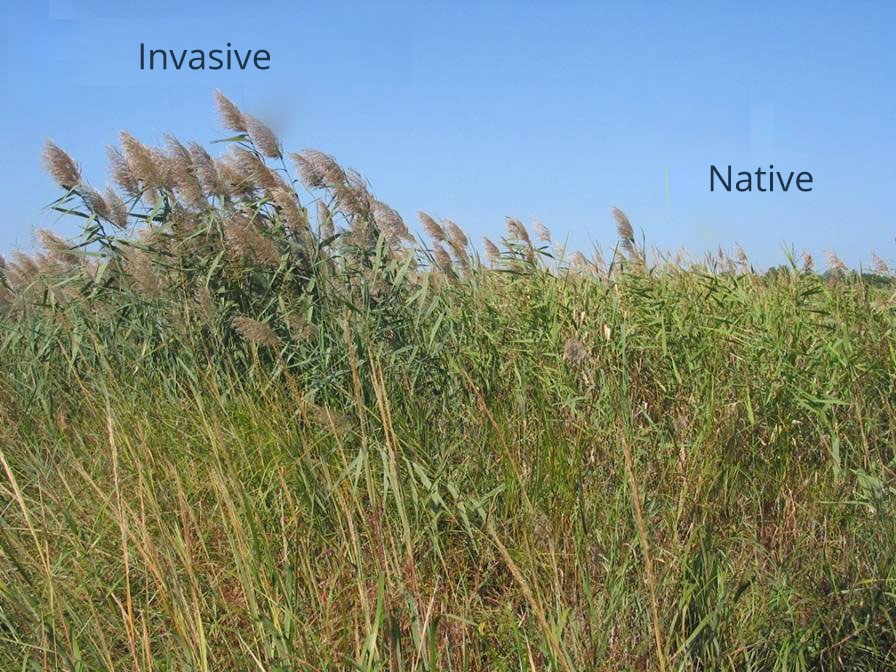
Invasive Phragmites
Why it’s bad
Not only do invasive Phragmites crowd out other plants and out-compete them for water and nutrients, but their roots can also be toxic, too! These toxins are released into the soil and can kill plants in the surrounding area.
Where you might find it
Invasive Phragmites are widespread throughout North America, and can easily be found in many parts of Southern Ontario. They’ve even been called Ontario’s worst invasive species!
How to identify it
Invasive Phragmites can be hard to identify since they closely resemble Native Phragmites. Generally speaking, invasive Phragmites are taller than the native variety (up to 5 metres for the invasive kind). Invasive Phragmites also grow in denser bunches than their native counterparts, and have stems that are tan or beige in colour.
When trying to identify invasive Phragmites vs. native Phragmites, check to see if there are other types of plants nearby. The invasive species will crowd out other plants, while the native species will be found among other plants that do not closely resemble it.
How to help
Inspect, wash, and dry any clothing, equipment, and even pets that may have come into contact with invasive Phragmites. We don’t want their seeds to spread.

Yellow Floating Heart
Why it’s bad
Yellow Floating Heart can impede the ability of native plants to grow by taking up so much space! Just like other aquatic invasive plants, they can also reduce dissolved oxygen levels thus harming fish and other living organisms. They can also make it very difficult to swim in, boat, and generally enjoy the waters they occupy.
Where you might find it
In Canada, Yellow Floating Heart has been reported in lakes in Southern Ontario, Quebec, and Nova Scotia. It has also been reported in several US states.
How to identify it
Like the name suggests, Yellow Floating Heart is known for its bright yellow flowers and heart shaped leaves. Each flower will contain five petals, while leaves will be 3 to 10 cm wide. The plant’s roots are located below the surface of the water, and may be 1 metre or more in length. The stems will be rooted to the bottom of the waterbody.
How to help
Yellow Floating Heart can be difficult to remove, since its elimination requires the removal of all parts of the plant, roots included. Make sure to wash, clean, and dry all boats and equipment that may have been in Yellow Floating Heart-infested waters. Your boat’s propeller could cause small parts of the plant to break off and spread, too- so avoiding these areas all together may be a wise decision, if possible!
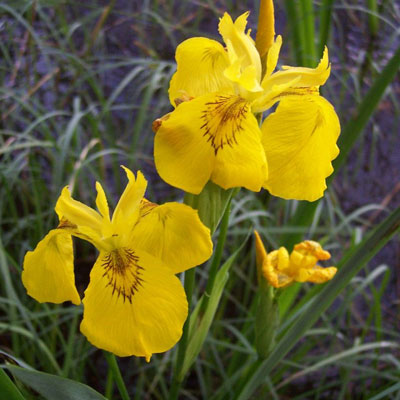
Yellow Iris
Why it’s bad
Once established, Yellow Iris plants have thick underground stems that consume a lot of water and displace native plant and animal species. Yellow Iris is also poisonous to both animals and humans, and even just touching the plant can cause your skin to get irritated!
Where you might find it
Yellow Iris can be found in most Canadian provinces. Since it’s an aquatic plant, you’ll find it where there’s water!
How to identify it
Flowers have three big drooping petals and three smaller upright petals, all of which are yellow.
Plants also have flat leaves stemming from the base that are two to three centimetres wide and up to one metre long.
How to help
Choose native Iris species when gardening! Professionals at gardening centres may be able to help you distinguish between invasive and native species.
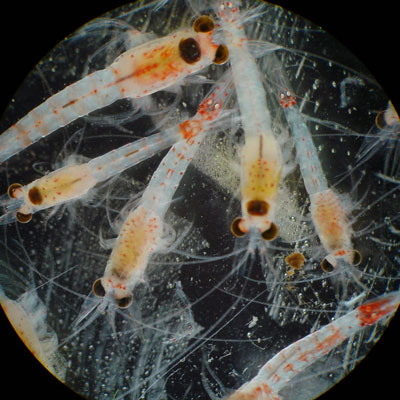
Bloody Red Shrimp
Why it’s bad
The impact of Bloody Red Shrimp on North America’s freshwater lakes isn’t well understood, but they are believed to reduce the amount of food available for native species.
Where you might find it
Bloody Red Shrimp has been found in all of the Great Lakes and in other parts of Ontario and the northeastern United States.
How to identify it
Bloody Red Shrimp are translucent with bright red to reddish-orange colouring, especially around the head and tail. They have large black eyes, and their tails are square with two spines at the end. Females can grow up to 1.7 cm long, while males will be smaller, up to 1 cm.
Bloody Red Shrimp travel in swarms and will usually be spotted in shady areas during the day. They avoid direct sunlight.
How to help
Inspect, rinse, clean, and dry your boat and other equipment before transporting them from one waterbody to another.
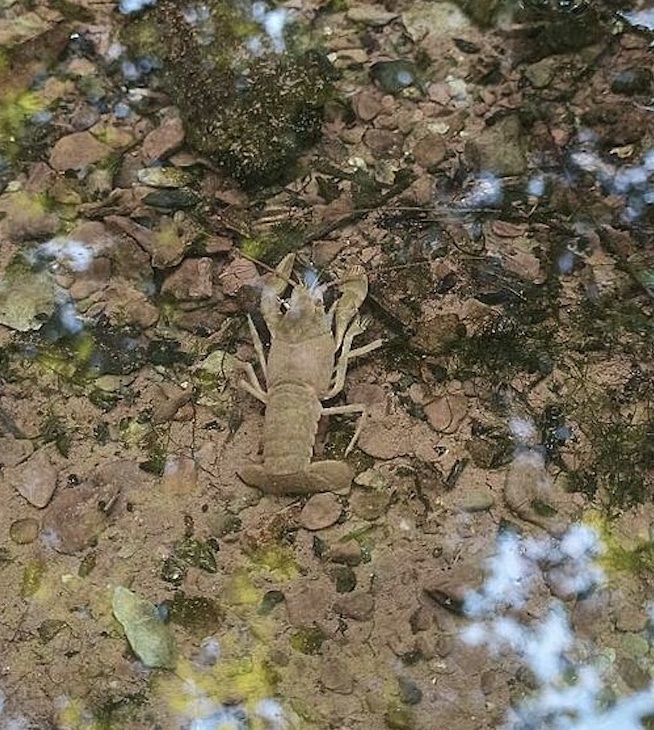
Rusty Crayfish
Why it’s bad
Compared to native crayfish, Rusty Crayfish are much larger and more aggressive. Because of this, they’re able to out-compete native crayfish species for food and space. Because they eat so much vegetation, they also reduce spawning habitat for native fish.
Where you might find it
While the Rusty Crayfish are native to the Ohio River Basin, they’ve now invaded several waterbodies in Ontario and the midwestern and northeastern United States.
How to identify it
Rusty Crayfish have “rusty” looking patches on each side of their shell- hence the name! They also have grayish-green to reddish-brown claws with black bands near the tips. When their claws are closed, you should be able to see an oval-shaped gap between them. Adults can grow up to 13 cm in length.
How to help
Once Rusty Crayfish are present in an area, they are extremely hard to get rid of. This is because they reproduce so fast! Because of this, prevention is key. Never use Rusty Crayfish as bait for fishing, unless you caught them from the same waterbody you’re fishing in.

Spiny Waterfleas
Why it’s bad
Spiny Waterfleas eat a lot of zooplankton, and drastically reduce the abundance of it as a result. This has cascading effects on entire ecosystems; if there’s less zooplankton, there’s less food for several species of fish as a result. If there’s less fish, there’s less food for other animals (and humans) as a result, too!
Where you might find it
Today, Spiny Waterfleas can be found in all of the Great Lakes and hundreds of other lakes in Ontario and the northern United States. They move towards deeper water during the day and are very difficult to identify with your eyes alone- you’ll likely need a microscope to identify them properly!
How to identify it
Spiny Waterfleas are very small- they only grow up to 1.5cm in length, and their tail makes up 60% of this! Other identifying features include a single dark eye and four pairs of legs. They can appear orange, blue, or green in colour, and have a balloon-shaped egg pouch on their back.
How to help
You can help prevent the spread of Spiny Waterfleas by always draining, cleaning, and drying your boat and other fishing equipment on dry land. Also make sure to never dump your unused fishing bait into the water- it should be dumped and disposed of on dry land, a good distance away from the shoreline.

Zebra Mussels
Why it’s bad
Zebra mussels are extremely efficient at filtering water, thus removing plankton from it. This is bad, because fish and other organisms are dependent on plankton as a food source! Not only that, but filtered water is clearer water- while this sounds like a good thing, it actually allows more light to penetrate the water. This contributes to more plant and algae growth, which can lead to eutrophication as the plants and algae die off. Zebra mussels also attach themselves to native mussels, suffocating them in the process.
Where you might find it
Zebra mussels can be found in all of the Great Lakes, the St. Lawrence River, Lake St. Clair, the Mississippi River Watershed, Lake Winnipeg, Red River, and Nelson River. As per the Government of Canada’s website, zebra mussels haven’t been found any further west than Manitoba- yet.
How to identify it
Zebra mussels are usually 2-2.5 cm in length, but can grow up to 4 cm. They are triangular in shape, and have a flat underside. They’re usually black or brown with a white, zig-zagged pattern- hence the name “zebra” mussel.
How to help
Always inspect, clean, and dry your boats and recreational equipment after use. Boats and other equipment should be cleaned thoroughly with hot or high pressure water, or should be left to dry in the sun for a few days. Always drain motors, buckets, etc. on land rather than in water.
Want to know more?
You can learn more about invasive plant and animal species in Canada from the Invasive Species Centre.
Learn about other invasive species
Saskatchewan has a bunch of unique invasive species- check them out!